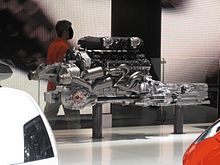When Ferruccio Lamborghini set out to provide Ferrari with competition, he contractedGiotto Bizzarrini to design the engine for his car and, according to some accounts, paid him a bonus for every horsepower over what Ferrari's V12 could produce. The finished 3.5-litre (214 cu in) V12 was such that, with minor modifications and improvements, the very same engine (in 6.5 litre form) powered the Lamborghini Murciélago LP 640, and completed its service for Lamborghini with the ultimate final version of the Murciélago, the Murciélago LP 670-4 SuperVeloce.[3]Lamborghini's all-new 6.5 litre engine for their 2011 Aventador produces 700 PS (510 kW; 690 hp).[4]
The engine was designed from the start to be a "quad cam" (two overhead camshafts per cylinder bank) 60 degree V12 - as an intentional snub by Mr. Lamborghini of Ferrari's single overhead camshaft per-bank design. When the 3,464 cubic centimetres (211.4 cu in) prototype was tested in 1963, it was able to produce 370 brake horsepower (276 kW; 375 PS) at 9,000 revolutions per minute(rpm) - a figure of almost 107 brake horsepower (80 kW; 108 PS) per litre, and unprecedented at the time. Bizzarrini famously insisted that the engine was mechanically capable of reaching an astonishing 400 brake horsepower (298 kW; 406 PS) at 11,000 rpm with an uprated fuel system, but the design was judged adequate, and when fitted with production carburettors, all the auxiliary systems, and detuned for road use, the engine still made an impressive 280 brake horsepower (209 kW; 284 PS).
Audi ownership
Over the years, notably since Lamborghini was purchased by the German Volkswagen Group subsidiary AUDI AG, this V12 engine has nearly doubled in displacement - first to 6,192 cubic centimetres (377.9 cu in), and later to 6,496 cubic centimetres (396.4 cu in). It has seen the modification of the cylinder heads to allow four valves per cylinder, the replacement of Weber carburettors with electronic fuel injection, and the re-engineering of the lubrication system from a wet sump to a dry sump design. However, the engine that powers the current Murciélago LP 640 can trace its lineage directly to the F1-inspired design of Bizzarrini and his team more than forty years ago.[citation needed]
Specifications
- engine configuration — 3.5 & 4.0[1][2]
- 60° V12 engine; wet sump lubrication system
- engine configuration — 6.2 & 6.5
- 60° V12 engine; dry sump lubrication system
- engine displacement etc.
- 3.5: 3,465 cubic centimetres (211.4 cu in); bore x stroke: 77.0 by 62.0 millimetres (3.03 in × 2.44 in) (stroke ratio: 1.24:1 - 'oversquare/short-stroke engine'); 288.7 cc percylinder[2]
- 4.0: 3,929 cubic centimetres (239.8 cu in)
- 6.2: 6,192 cubic centimetres (377.9 cu in); bore x stroke: 87.0 by 86.8 millimetres (3.43 in × 3.42 in) (stroke ratio: 1.00:1 - 'square engine'); 516.0 cc per cylinder; compression ratio: 11.6:1
- 6.5: 6,496 cubic centimetres (396.4 cu in); bore x stroke: 88.0 by 89.0 millimetres (3.46 in × 3.50 in) (stroke ratio: 0.99:1 - 'square engine'); 541.3 cc per cylinder; compression ratio: 11.8:1
- cylinder block & crankcase[1]
- cast aluminium alloy; pressed-in cylinder liners
- cylinder heads & valvetrain — 3.5 & 4.0[1]
- cast aluminium alloy; two valves per cylinder, 24 valves total, chain-driven double overhead camshaft
- cylinder heads & valvetrain — 6.2 & 6.5
- cast aluminium alloy; four valves per cylinder, 48 valves total, chain-driven double overhead camshaft
- aspiration, fuel system & ignition system — 3.5[2]
- six twin-barrel side-draught Weber 40 DCOE 2 carburettors; one or two ignition distributors
- aspiration, fuel system & ignition system — 4.0
- six twin-barrel down-draught carburettors; one or two ignition distributors
- aspiration, fuel system & ignition system — 6.2 & 6.5
- two air filters, four cast alloy throttle bodies each with Magneti Marelli electronically controlled 'drive by wire' throttle butterfly valves, cast magnesium alloy intake manifold; two linked common rail fuel distributor rails, electronic sequential multi-point indirect fuel injection with intake manifold-sited fuel injectors; centrally positioned spark plugs, mapped direct ignition with 12 individual direct-acting single spark coils
- exhaust system — 6.2 & 6.5
- two 3-branch exhaust manifolds per cylinder bank, connected to dual-inlet catalytic converters, heated oxygen (lambda) sensors monitoring pre- and post-catalyst exhaust gasses
- power and torque outputs and applications[1]
- 3.5: 284 metric horsepower (209 kW; 280 bhp) @ 6,500 rpm; 325 newton metres (240 lbf·ft) @ 4,500 rpm — Lamborghini 350GT
- 3.5: 324 metric horsepower (238 kW; 320 bhp) @ 7,000 rpm — Lamborghini 350GT Veloce
- 4.0:
- 6.2: 580 metric horsepower (427 kW; 572 bhp) @ 7,500 rpm; 650 newton metres (479 lbf·ft) @ 5,500 rpm —
- 6.5: 640 metric horsepower (471 kW; 631 bhp) @ 7,500 rpm; 660 newton metres (487 lbf·ft) @ 5,200 rpm — Lamborghini Murciélago LP 640 Coupé and Roadster
- 6.5: 650 metric horsepower (478 kW; 641 bhp) — Lamborghini Reventón and Murciélago LP 650-4 Roadster
- reference
- German press release: auto katalog 2006
- 6.5: 670 metric horsepower (493 kW; 661 bhp) @ 8,000 rpm; 660 newton metres (487 lbf·ft) @ 6,500 rpm — Lamborghi




0 comments:
Post a Comment